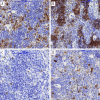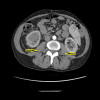A Case of Multifocal Extramedullary and Non-Hepatosplenic Extramedullary Hematopoiesis in a 43-Year-Old Man with a History of Congenital Eisenmenger Syndrome
- PMID: 35332114
- PMCID: PMC8965630
- DOI: 10.12659/AJCR.935141
A Case of Multifocal Extramedullary and Non-Hepatosplenic Extramedullary Hematopoiesis in a 43-Year-Old Man with a History of Congenital Eisenmenger Syndrome
Abstract
BACKGROUND Extramedullary hematopoiesis in organs outside the bone marrow most commonly occurs in the liver and spleen. This report is of a case of multifocal extramedullary and non-hepatosplenic extramedullary hematopoiesis a 43-year-old man with a history of congenital Eisenmenger syndrome. CASE REPORT We present the case of a 43-year-old patient with complex heart disease and full-blown Eisenmenger syndrome associated with ventricular septal defect, bicuspid right ventricle, and pulmonary hypertension. In July 2020, the patient began to report neurological symptoms in the form of lower-limb numbness and weakness of lower-limb strength, with additional increasing lower-limb edema. A CT scan of the abdomen and pelvis revealed a 63×102×103 mm soft-tissue mass in the pelvis, located behind the urinary bladder. Due to the suspicion of proliferative disease, mainly of the lymphatic system, a diagnostic trephine biopsy was performed first, but no tumor cell infiltration was found. Then, the patient was qualified for diagnostic surgery. During the operation, tumor sections were harvested. Histopathological examination of the tissue sections showed extramedullary hematopoiesis in the tumor lining. Hydroxycarbamide was used as first-line treatment. However, it was not effective in controlling clinical symptoms. Therefore, the patient was qualified for radiotherapy as a second-line palliative treatment. CONCLUSIONS This report presents a patient with cyanotic heart disease and extramedullary and non-hepatosplenic hematopoiesis presenting as masses that mimicked malignancy. In this case, palliative radiotherapy effectively reduced the symptoms due to the size of the mass lesion.
Conflict of interest statement
Figures



Similar articles
-
The role of T2*-weighted gradient echo in the diagnosis of tumefactive intrahepatic extramedullary hematopoiesis in myelodysplastic syndrome and diffuse hepatic iron overload: a case report and review of the literature.J Med Case Rep. 2018 Jan 15;12(1):9. doi: 10.1186/s13256-017-1531-9. J Med Case Rep. 2018. PMID: 29332607 Free PMC article.
-
Hidden in the mediastinum: a case of extramedullary hematopoiesis unveiled through thoracoscopy.J Int Med Res. 2024 Jan;52(1):3000605231221088. doi: 10.1177/03000605231221088. J Int Med Res. 2024. PMID: 38190843 Free PMC article.
-
Mass-like extramedullary hematopoiesis: imaging features.Skeletal Radiol. 2012 Aug;41(8):911-6. doi: 10.1007/s00256-011-1323-z. Epub 2011 Nov 20. Skeletal Radiol. 2012. PMID: 22101909
-
Pulmonary extramedullary haematopoiesis managed by radiation therapy: A case report and review of literature.Cancer Radiother. 2025 May;29(3):104628. doi: 10.1016/j.canrad.2025.104628. Epub 2025 May 15. Cancer Radiother. 2025. PMID: 40378622 Review.
-
Invasive methods for the diagnosis and management of intrathoracic extramedullary hematopoiesis: A literature review.Respir Med Res. 2021 May;79:100815. doi: 10.1016/j.resmer.2021.100815. Epub 2021 Feb 5. Respir Med Res. 2021. PMID: 33610912 Review.
References
-
- Short C, Lim H, Tan JKH, O’Neill HC. Targeting the spleen as an alternative site for hematopoiesis. BioEssays. 2019;41(5):e1800234. - PubMed
-
- Sohawon D, Lau KK, Lau T, Bowden DK. Extra-medullary haematopoiesis: A pictorial review of its typical and atypical locations. J Med Imaging Radiat Oncol. 2012;56(5):538–44. - PubMed
-
- Taylor CL, Maynard F, Liebman J, et al. Extramedullary hematopoiesis causing paraparesis in congenital cyanotic heart disease. Neurology. 1998;51(2):636–37. - PubMed
-
- Karimi M, Cohan N, Pishdad P. Hydroxyurea as a first-line treatment of extramedullary hematopoiesis in patients with beta thalassemia: Four case reports. Hematology. 2015;20(1):53–57. - PubMed
Publication types
MeSH terms
LinkOut - more resources
Full Text Sources
Medical

